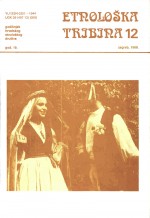Sezonske varijacije vjenčanih u sjevernoj Hrvatskoj
Seasonality of Marriage in Northern Croatia
Author(s): Jasna ČapoSubject(s): Customs / Folklore, Ethnohistory, Cultural Anthropology / Ethnology, 16th Century, 17th Century, 18th Century, Migration Studies
Published by: Hrvatsko etnološko društvo
Keywords: seasonality of marriage; northern Croatia; 18th and 19th centuries; migration from the Balkan; cultural anthropology;
Summary/Abstract: The author has analyzed spatial distribution of seasonality of marriage in north and central Croatia in the 18th and 19th centuries. She has found that in north-west Croatia, until the middle of the 19th century, the season with the highest number of contracted marriages was winter. Starting from the 1830s, a secondary, autumn maximum emerged. In the north-east Croatia, autumn had been and remained the principal marriage season in the 18th and 19th centuries. A mixture of both maxima was located in central Croatia, especially along the border of the regions with different marriage seasons. The territory of northern Croatia can be fitted quite well into the European context At the end of the 19th century the surrounding countries had all a mixture of autumn and winter marriage season. The north-west of Croatia was contiguous to the pattern of those northern and north-west areas with the winter maximum (Hungary, Slovene countries, Italy), while the north-east of Croatia bordered on the pattern of those southern and eastern areas with the domination of the autumn maximum (Bosnia and Herzegovina, Serbia and Greece). The spatial distribution of the season of marriage in southern Europe does not help explain the observed distribution of the two patterns in northern Croatia. Economic and religious moments are insufficient, too. The author has attempted to explain the difference in the time of marriage between west and east of northern Croatia by looking at population movements from the Balkan peninsula to the north, from the 16th to the 18th centuries. She has made a claim that the settlers to north-east Slavonia either brought a completely new pattern of the season of marriage (the implication being that all of north Croatia previously had the same marriage season — winter) or reinforced the already existing pattern (with the implication that there had been a difference in the marriage season between north-west and north-east Croatia even before large migrations of the period between the 16th and 18th centuries).
Journal: Etnološka tribina : Godišnjak Hrvatskog etnološkog društva
- Issue Year: 19/1989
- Issue No: 12
- Page Range: 5-20
- Page Count: 16
- Language: Croatian

